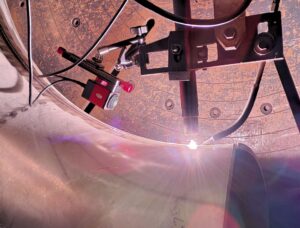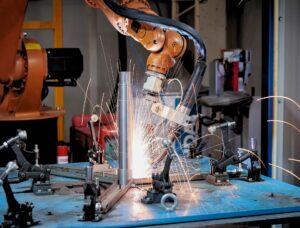Welding is the process of joining metals using heat and pressure to create a strong bond. It plays a crucial role in industries like construction, manufacturing, automotive, aerospace, and shipbuilding. Whether it’s MIG welding, TIG welding, or stick welding, mastering welding techniques ensures high-quality welds and minimizes weld defects like slag inclusion and porosity. With advancements in welding technology, tools like welding cameras and weld monitoring systems allow for real-time weld inspection, improving precision and efficiency. In this guide, we’ll explore how welding works, welding process and uses, applications, and how welding inspection techniques enhance weld quality.
How Does Welding Work?
At its core, welding fuses metals using high temperatures, electrical current, or pressure. Unlike soldering or brazing, welding melts the base metal to form a strong, permanent bond.
Key Elements of the Welding Process and Uses
- Heat Source: Generates the necessary temperature for metal fusion.
- Filler Metal: Used in some processes to strengthen the weld joint.
- Shielding Gas or Flux: Protects the weld from contamination.
- Welding Equipment: Includes power sources, torches, electrodes, and monitoring tools.
A welding camera provides real-time monitoring to ensure arc stability and prevent common weld defects.
Types of Welding Process and Uses
1. MIG Welding (Metal Inert Gas Welding)
- Uses a wire electrode and a shielding gas like argon or CO₂.
- Ideal for automotive, construction, and industrial applications.
- Fast and efficient, producing minimal spatter.
- Commonly used for: MIG and MAG welding process.
2. TIG Welding (Tungsten Inert Gas Welding)
- Uses a non-consumable tungsten electrode and a shielding gas.
- Produces high-precision welds, great for thin materials and delicate work.
- Requires a skilled welder due to the manual feed of filler metal.
3. Stick Welding (Shielded Metal Arc Welding – SMAW)
- Uses a flux-coated electrode that creates a protective gas shield.
- Works well in outdoor environments and construction sites.
- Effective for welding thick materials but can produce slag.
4. Plasma Arc Welding
- Similar to TIG welding but uses a constricted arc for higher precision.
- Used in aerospace and medical device manufacturing.
5. Laser Welding
- Uses a high-energy laser beam to fuse metals.
- Perfect for automotive and electronic applications due to its precision.
Weld monitoring cameras enhance quality control in advanced processes like laser welding and plasma arc welding.
Applications of Welding
1. Construction and Infrastructure
- Welding is essential in building bridges, skyscrapers, and pipelines.
- Arc welding methods like stick and MIG welding are widely used.
2. Manufacturing Industry
- Used in automobile production, shipbuilding, and appliance manufacturing.
- Robotic welding systems improve speed and efficiency.
3. Aerospace and Defense
- Critical for aircraft structures and engine components.
- TIG welding is preferred for its precision and strength.
4. Oil and Gas Industry
- Welding is crucial for pipeline construction and maintenance.
- Requires advanced welding inspection techniques for safety.
5. Shipbuilding and Marine Engineering
- Welding ensures water-tight seals and structural integrity.
- Weld visual inspection and monitoring systems are crucial for quality control.
A welding camera allows for real-time inspection of critical welds in industries where precision is non-negotiable.
The Importance of Welding Inspection and Monitoring
Ensuring strong, defect-free welds requires careful weld inspection and quality control.
Weld Monitoring Cameras:
- Capture real-time arc welding images for quality assessment.
- Help detect and prevent weld defects like porosity and slag inclusion.
- Improve precision in robotic welding applications.
Welding Inspection Techniques:
- Visual Inspection: Identifies surface defects.
- X-ray & Ultrasonic Testing: Detects internal flaws.
- Dye Penetrant & Magnetic Particle Testing: Finds cracks in critical structures.
Using a weld monitoring system ensures better weld quality and reduces rework costs.
How to Improve Welding Quality
Follow these best practices to enhance welding precision and durability.
- Choose the Right Welding Equipment: Different materials require specific processes.
- Maintain Proper Heat Control: Prevents distortion and weld problems.
- Use a Weld Monitoring System: Helps adjust parameters in real time.
- Ensure Proper Workpiece Preparation: Clean metal surfaces for stronger welds.
- Practice Good Welding Techniques: Maintain consistent speed and angle.
Advanced welding technology, including real-time monitoring with welding cameras, helps achieve superior welds.
Conclusion: Welding’s Role in Modern Industry
Welding is the backbone of modern manufacturing, construction, and infrastructure development. Whether you’re working with MIG welding, TIG welding, or advanced robotic welding, monitoring weld quality is essential for success.
Mecaweld provides high-quality welding cameras and weld monitoring systems to improve precision, efficiency, and safety. Contact us today to learn how our welding inspection technology can help optimize your welding process!



